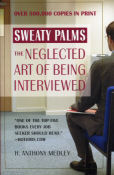| What REALLY goes on in a job interview? Find out in the new revision of "Sweaty Palms: The Neglected Art of Being Interviewed" by Tony Medley, updated for the world of the Internet . Over 500,000 copies in print and the only book on the job interview written by an experienced interviewer, one who has conducted thousands of interviews. This is the truth, not the ivory tower speculations of those who write but have no actual experience. "One of the top five books every job seeker should read," says Hotjobs.com. Click the book to order. Now also available on Kindle. | |
|
Amy (9/10) by Tony Medley Runtime 128 minutes. Not for children. By the early age of 27, Amy Winehouse had won six Grammys and was a household word. But the word was not necessarily for her music. She was an extremely damaged person despite her success and she never reached her 28th birthday, putting her in the “27 Club” which includes 15 musicians who died at that age including Jim Morrison, Jimi Hendrix, Janis Joplin and Kurt Cobain. Amy was known to most of the world as, sure, a famous jazz singer, but her overriding repute was as an out of control drug addict. This is a no-holds barred look at her turbulent life. It has some amazing scenes, almost as if her life were a feature motion picture and cameras were always there to capture events, both public and private, that shaped her life and reputation. Director Asif Kapadia has produced a truly remarkable documentary of her life with astounding editing by Chris King. The film includes some of Amy’s performances, which showcase her talent. One of the many moving scenes is the backstage filming of her recording of a duet with Tony Bennett. Bennett was one of her idols and she is shown interfacing with him and telling him how uncomfortable and nervous she was to be working with him before finally coming through with a haunting performance of “Body and Soul.” I’m no fan of Tony Bennett, but I’d love to hear this again. Bennett is later shown talking about what a remarkable talent he considered her to be. But the film is not without controversy. Amy’s father, Mitch, controls the Winehouse estate, so without him it would have been virtually impossible to make the film. To his everlasting discredit, Mitch discouraged Amy’s going to rehab, which is part of the subject of her hit, “Rehab.” At first Mitch was cooperative but when he saw the final cut he criticized its representation of him and demanded that it be re-edited. Producer James Gay-Rees declined the suggestion and Mitch’s actions are disclosed in detail. Amy’s husband, Blake Fielder, who is pictured as being an accessory, if not a prime mover, in getting Amy deeper into drugs, might also have some complaints with the way he is pictured. But he knew he was being interviewed, and so did Mitch, so how can they complain? With a father like Mitch and a husband like Blake, poor Amy was starting out with two strikes on her. Also interviewed are many of her friends and people with whom she worked, although most were reluctant because they wanted to protect Amy. Kapadia says that they finally felt like they should tell Amy’s side of the story, “It was like therapy for them in some way. There were a number of people who were becoming unwell because they were carrying this weight, knowing what they knew. And I was impartial. I wasn’t part of the music business. I had no agenda and most of them felt better afterwards.” Even with the more than 100 interviews, the story is told primarily through Amy’s mostly autobiographical lyrics. They are shown on the screen throughout the movie. Another matter the film shows more graphically than I’ve seen before is the condemnation of celebrity stars to the glare of the media and the paparazzi. What Amy went through is dreadful and scary and probably contributed to her demise. This is a warts and all movie that is shocking and sad, even if you know the story, a film you will remember long after others have faded.
|
|
|
|
|
